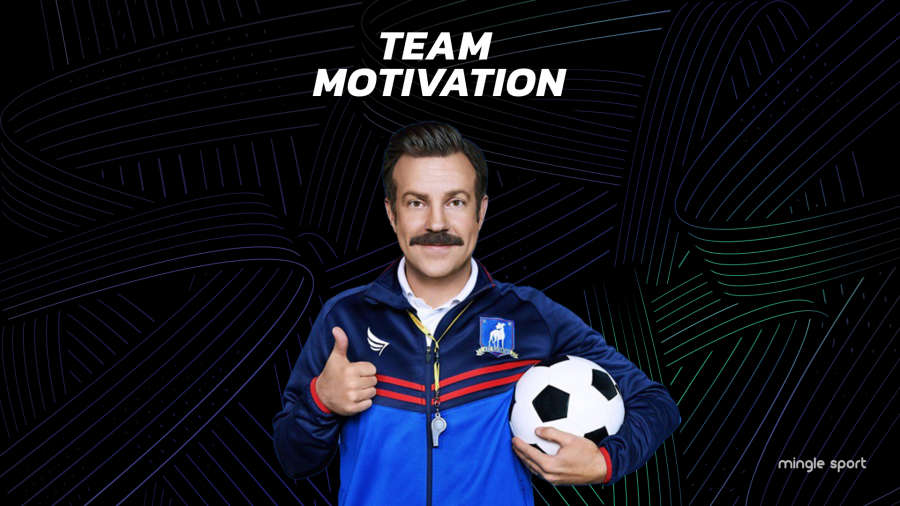The science behind team motivation

Many football teams engage in team building activities. But why is this so important? How does motivation affect team performance? And what role can you play as a coach to increase your team’s motivation?
Different types of motivation in football
When looking at what motivates someone to engage in sport, the Social Determination Theory (SDT) [Source: Deci & Ryan, 1985] is often used [Source: Orbach et al, 2021]. This theory states that there are different types of motivation, ranging from not being motivated (’amotivation’), to being motivated by external factors such as benefits for health, peer pressure or tangible rewards (’extrinsic motivation’), to being motivated because you truly enjoy doing the sport (’intrinsic motivation’).
Motivation ranges from external to internal. Below 4 types of motivation that are relevant for football coaches.
| MOTIVATION | DESCRIPTION |
|---|---|
External (extrinsic) | I’m doing this because of a reward or penalty I receive |
Somewhat External | I’m doing this because I feel guilty or think I ought to do this |
Somewhat Internal | I’m doing this because I personally value the goal |
Internal (intrinsic). | I’m doing this because it is important to my self worth |
Not surprisingly, an athlete that is internally motivated is more likely to keep on playing sports [Source: Ryan & Deci, 2000a, 2000b; Orbach et al., 2021].
Also, the SDT indicates that to become motivated a player’s 3 psychological needs must be fulfilled. These are:
The need for autonomy: the player needs to feel independent and in control of their actions.
The need for competence: the player needs to feel competent in the activity they are performing.
The need for relatedness: the player needs to feel a sense of belonging while playing football.
Importance of team building
Team building is essential for creating a sense of connectedness and belonging, making the sport more fun for every player [source: 1&2 in Cheng, 2024]. A positive team environment can influence the needs outlined above of each individual player [source: Grenier, Gagné & O’Neill, 2023].
A team that works well together creates a less stressful, more enjoyable, and more rewarding environment for all team members. It results in a greater benefit for the team and all players involved [Cheng, 2024].
Practical tips for improving team motivation
Based on scientific research we know that internal motivation creates better players and teams.
Make clear goals with the team. Involve the players in setting these goals. E.g. what position do we want to achieve this season? How important is performance for us as a team? Should every player play equal time on the pitch? What aspects do we want to work on as a team? What is your personal goal for this season?
As a coach you lead by example. You expect a positive mindset and internal motivation from everyone. So that’s what you need to communicate.
Some practical tips:
Sharing expectations with one another.
e.g. what do you expect from me as a coach in matches, during trainings etc.?Let players participate in the planning process.
e.g. let them set personal development goals.Demonstrate a positive attitude toward teamwork
e.g. give players that demonstrate good teamwork a compliment.
Involve an internal team leader.
e.g. elect a team captain and give this player clear responsibilities within the teamProvide opportunities for feedback
e.g. after a match sit down, ask what each player thought about the match. Ask them to openly reflect on something that went well and something they thought could have gone better. Also, provide opportunities to provide feedback on the team processes in private.Emphasize the team’s progress in terms of internal motivation, instead of external motivation
e.g. emphasize a player’s growth or enthusiasm shown during a match or training.
And finally, organise team building activities. Ideally 3 times a season. At the beginning of the season to get to know each other better. Midway to evaluate and get ready for the second half. And at the end of the season to celebrate team success or failures.
This article is based on research from:
Ainley, M. (2007). Being and feeling interested: Transient state, mood, and disposition. In *Emotion in education* (pp. 147-163). Academic Press. https://doi.org/10.1016/B978-012372545-5/50010-1
Burns, R. D., Fu, Y., & Podlog, L. W. (2017). School-based physical activity interventions and physical activity enjoyment: A meta-analysis. *Preventive medicine*, *103*, 84-90. https://doi.org/10.1016/j.ypmed.2017.08.011
Chen, X. (2024). Dimensions of Team Effectiveness: Towards an Improved Team-Building Program for Beginning Athletes. *Journal of Education and Educational Research*, *7*(1), 130-132. https://doi.org/10.54097/h77xec97
Deci, E. L., & Ryan, R. M. (1985). The General Causality Orientations Scale: Self- Determination in Personality. Journal of Research in Personality, 19, 109-134. [https://doi.org/10.1016/0092-6566(85)90023-6](https://doi.org/10.1016/0092-6566(85)90023-6)
Deci, E. L., & Ryan, R. M. (2000). The “what” and “why” of goal pursuits: Human needs and the self- determination of behavior. *Psychological Inquiry, 11(4),* 227–268. https://doi.org/10.1207/ S15327965PLI1104_01
Grenier, S., Gagné, M. and O’Neill, T. (2023). Self-Determination Theory and Its Implications for Team Motivation. *Applied Psychology,* 1-33. https://doi.org/10.1111/apps.12526
Orbach, I., Gutin, H., Hoffman, N. and Blumenstein, B. (2021). Motivation in Competitive Sport among Female Youth Athletes. *Psychology, 12,* 943-958. https://doi.org/10.4236/psych.2021.126057


